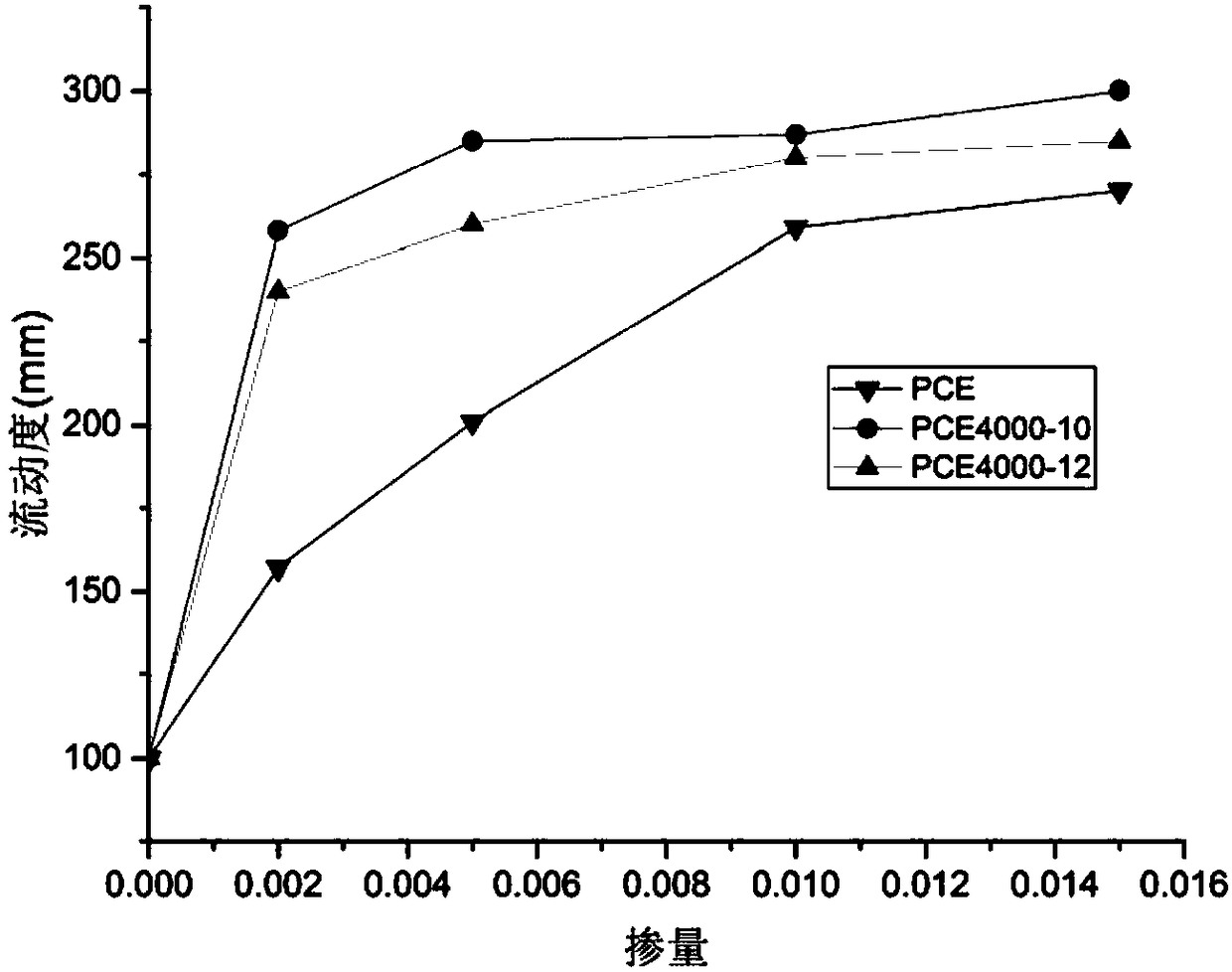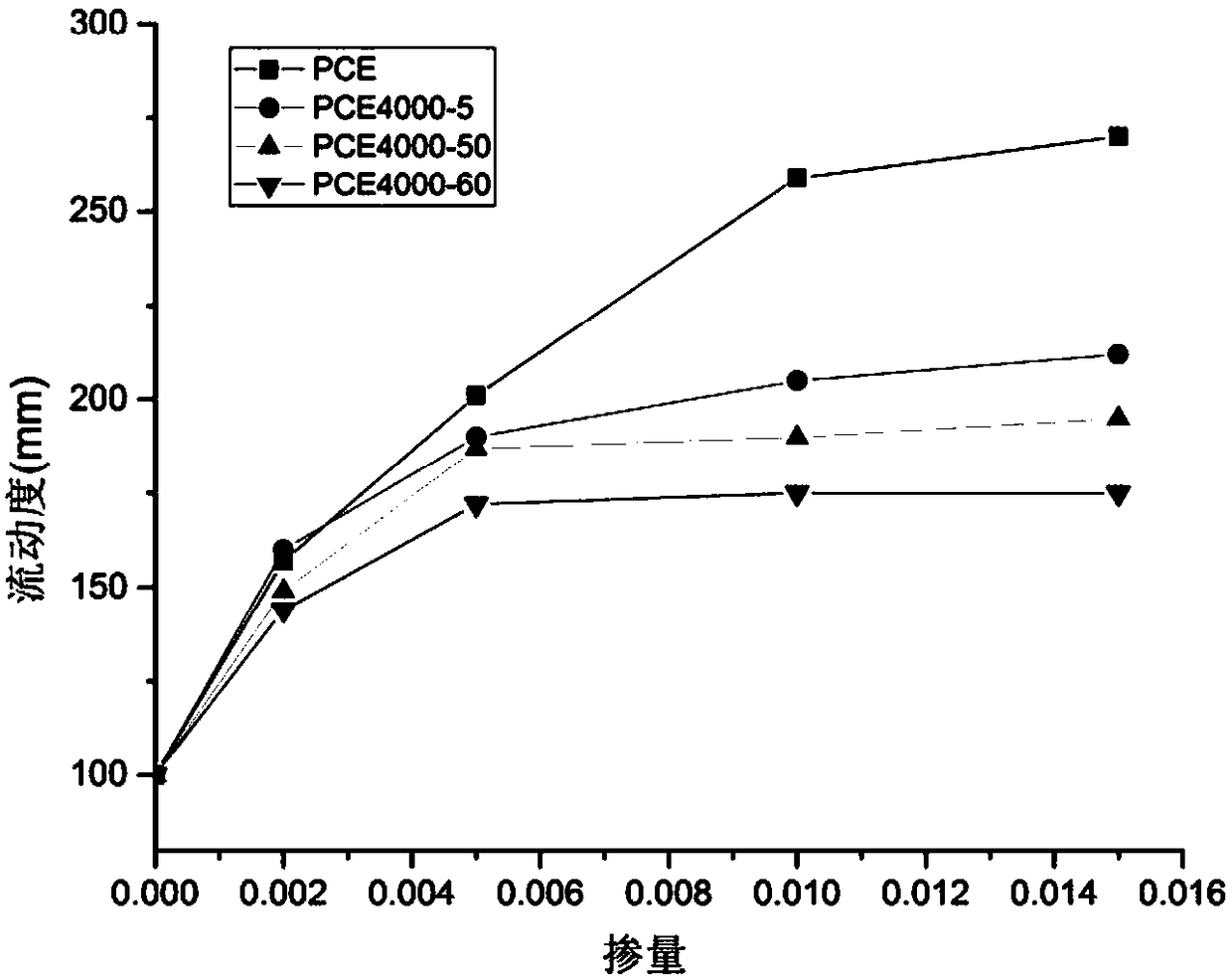Polycarboxylic acid and use thereof in cement
A polycarboxylic acid and application technology, applied in the field of polycarboxylic acid and its application in cement, can solve the problems of large dosage, poor flow retention or slump retention, small initial fluidity or slump, and achieve Meet the engineering requirements, improve the effect of water reduction and dispersion, prolong the effect of maintaining slump and fluidity
- Summary
- Abstract
- Description
- Claims
- Application Information
AI Technical Summary
Problems solved by technology
Method used
Image
Examples
Embodiment 1
[0058] Synthesis of PCE4000-10: Weigh 82g of water and 50g of HPEG, dissolve and mix evenly, pour into a three-necked flask in a constant temperature water bath, stir at a constant speed of 150rpm with the stirring paddle and raise the temperature to 65°C, weigh 0.37g of HPEG with a mass concentration of 30% 2 o 2 Added to the three-necked flask. Mix 9g AA and 24g water uniformly to prepare dropwise A, and mix 0.204g3-MPA, 0.125gVc and 25g water uniformly to prepare dropwise B. Drop A and drop B are added dropwise into the three-necked flask through a peristaltic pump at a constant speed. The drop time for A is 3 hours, and the time for B drop is 3.5 hours. After the dropwise addition is completed, keep warm for 1 h. After the reaction, the actual solid content test was carried out, and the test result was 29.8%.
Embodiment 2
[0060] Synthesis of PCE4000-12: Weigh 82g of water and 50g of HPEG, dissolve and mix evenly, pour into a three-neck flask in a constant temperature water bath, stir at a constant speed of 150rpm with the stirring paddle and raise the temperature to 65°C, weigh 0.37g of HPEG with a mass concentration of 30% 2 o 2 Added to the three-necked flask. Mix 10.8g AA and 24g water uniformly to prepare dropwise A, and mix 0.241g3-MPA, 0.147gVc and 25g water uniformly to prepare dropwise B. Drop A and drop B are added dropwise into the three-necked flask through a peristaltic pump at a constant speed. The drop time for A is 3 hours, and the time for B drop is 3.5 hours. After the dropwise addition is completed, keep warm for 1 h. After the reaction, the actual solid content test was carried out, and the test result was 28.9%.
Embodiment 3
[0062] Synthesis of PCE4000-16: Weigh 150g of water and 80g of HPEG, dissolve and mix evenly, pour into a three-neck flask in a constant temperature water bath, stir at a constant speed of 150rpm with the stirring paddle and heat up to 65°C, weigh 0.77g of HPEG with a mass concentration of 30% 2 o 2 Added to the three-necked flask. Mix 23.04g AA and 50g water uniformly to prepare dropwise A, and mix 0.505g3-MPA, 0.308gVc and 30g water uniformly to prepare dropwise B. Drop A and drop B are added dropwise into the three-necked flask through a peristaltic pump at a constant speed. The drop time for A is 3 hours, and the time for B drop is 3.5 hours. After the dropwise addition is completed, keep warm for 1 h. After the reaction, the actual solid content test was carried out, and the test result was 28.4%.
PUM
 Login to View More
Login to View More Abstract
Description
Claims
Application Information
 Login to View More
Login to View More - R&D
- Intellectual Property
- Life Sciences
- Materials
- Tech Scout
- Unparalleled Data Quality
- Higher Quality Content
- 60% Fewer Hallucinations
Browse by: Latest US Patents, China's latest patents, Technical Efficacy Thesaurus, Application Domain, Technology Topic, Popular Technical Reports.
© 2025 PatSnap. All rights reserved.Legal|Privacy policy|Modern Slavery Act Transparency Statement|Sitemap|About US| Contact US: help@patsnap.com



